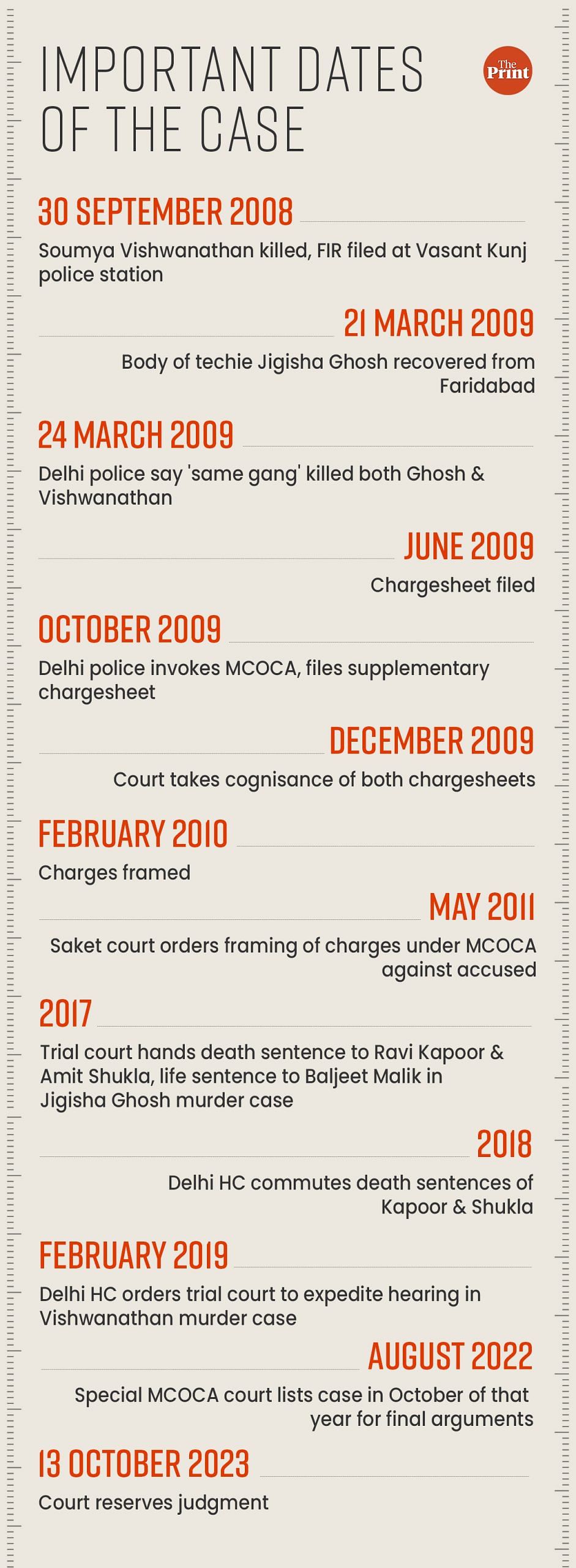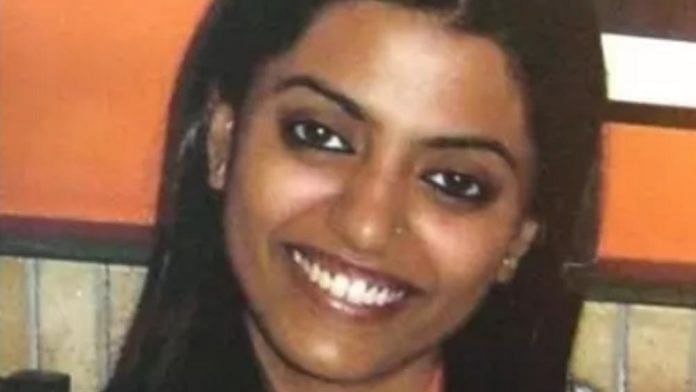New Delhi: A court in Saket is set to give its judgment Wednesday in the 15-year-old killing of journalist Soumya Vishwanathan in Delhi’s Vasant Vihar.
Vishwanathan, a 25-year-old journalist at Headlines Today — what is now India Today — was killed at Vasant Vihar’s Nelson Mandela Road in what police claimed was a case of armed robbery in the early hours of 30 September, 2008.
Five people — Ravi Kapoor, Amit Shukla, Baljeet Malik, Ajay Sethi, and Ajay Kumar — are facing charges under the stringent Maharashtra Control of Organised Crime Act (MCOCA) as well as charges of murder (Section 302), robbery (Section 390) and common intent (Section 34) under the Indian Penal Code (IPC).
On 14 October, additional sessions judge Ravindra Kumar Pandey reserved the ruling in the case.
Here, ThePrint looks at the timeline of events in this case.
Also Read: Not just a ‘lower court problem’: New book says 40% cases pending in Supreme Court for over 5 yrs
What happened that day
Vishwanathan was shot in the head as she was driving back home from work in the early hours of 30 September, 2008. According to court records, the local police station in Vasant Kunj received a phone call about the killing at 3.45 am.
The First Information Report (FIR) registered in this case the same day books unknown people for murder (Section 302 of the IPC).
But it wasn’t until a year after the killing that the police got any real breakthrough in its investigation. On 21 March, 2009, the body of techie Jigisha Ghosh was recovered from Faridabad. Police arrested three in connection with this case — Kapoor, Shukla, and Malik.
It was during questioning that Malik allegedly revealed the other accused’s alleged involvement in Vishwanathan’s murder. Later, two other people — Ajay Kumar and Ajay Sethi — were arrested in connection with the case.

Prime accused in the case
Ravi Kapoor: Until his arrest in March 2009, Kapoor was reportedly known to be a car thief and a police informer. Known to have several criminal antecedents, he was arrested in his first auto theft case in 2002, the Times of India said in a report dated 25 March, 2009.
Later, police claimed to have recovered the pistol that was used to kill Vishwanathan from Kapoor’s home, according to a report in The Indian Express published the same day.
Reports at the time had also suggested that Kapoor first shot at Vishwanathan to stop her car in a bid to attempt robbery but when she didn’t stop, he allegedly shot her fatally.
In October 2009, Kapoor threw chilli powder at police personnel in a bid to escape when he was brought to Delhi’s Safdarjung Hospital for treatment.
And in May 2010, he reportedly flashed a knife before a magistrate at the Patiala House Court during one of his hearings and claimed that he was ‘given the weapon by policemen to attack undertrials’ at Tihar jail, where he was lodged.
In 2018, the Delhi High Court granted him bail but it was stayed by the Supreme Court.
Amit Shukla: Shukla was one of Kapoor’s accomplices in the case and allegedly helped him take the fatal shot at Vishwanathan. According to reports, Shukla fled from Delhi two days after Vishwanathan’s murder and returned to Delhi a week before Ghosh was killed.
Baljeet Malik: Malik, who also went by the name Poppy, is believed to be the person whose confession gave police its much-needed breakthrough. According to media reports, the breakthrough came after Malik, who was arrested along with Kapoor and Shukla in connection with Ghosh’s killing, allegedly admitted to his involvement in the 2008 murder.
In 2019, after Malik submitted an application to the Delhi High Court to ask for the trial to be expedited, the latter asked the lower court why the case was being delayed. In its response, the trial court reportedly cited the absence of prosecution witnesses and the lack of a special public prosecutor.
Ajay Kumar: In April 2009, while Ajay Kumar was still on the run, Delhi Police had said he was “an important link to the case to the entire chain of events”. He was eventually arrested in 2009. In 2010, during one of his court hearings at the Patiala House Court Complex, Kumar reportedly attacked another accused in the case, Ajay Sethi, with a blade.
Ajay Sethi: A report in The Indian Express dated 7 April, 2009, quoted Delhi Police as having admitted that Sethi was not directly involved in the murder.
Sethi, who allegedly dealt in stolen vehicles, later claimed he was unaware that a stolen vehicle that Kapoor was trying to sell him was used in the murder of Vishwanathan.
Originally from Dehradun, Sethi was living in Faridabad at the time of the murder and was arrested in April 2009. He had also been arrested four times before he was finally arrested for Vishwananathan’s murder, The Indian Express report said.
MCOCA charges & subsequent delays
In October 2009, Delhi Police invoked the MCOCA against the five accused, saying that they were working as part of an “organised gang” — an essential element to invoke the stringent law. In its chargesheet, police listed Ravi Kapoor as the leader of the gang.
Police also believed invoking the stringent law would help the investigation since the accused were not supposed to get bail for at least six months, said a report in the Times of India dated 11 May, 2011.
For this, police also needed to trace previous FIRs against the accused.
After MCOCA was imposed, an assistant commissioner of police-rank officer was named the investigating officer — an upgrade from the Inspector-rank officer who was initially IO.
In 2014, public prosecutor Rajeev Mohan, who was handling the case since the start of the trial, reportedly quit to pursue private practice — a development that came as a major setback in the case. Then, in November 2015, then-Delhi Lieutenant Governor Najeeb Jung reappointed Mohan as the public prosecutor in the case.
In 2016, Soumya Vishwanathan’s father M.K. Vishwanathan approached Delhi Chief Minister Arvind Kejriwal about the delay in trial.
(Edited by Uttara Ramaswamy)
Also Read: Anjali Singh, Delhi’s hit-and-run victim, ‘risked life’ to earn for family & hoped to open salon



